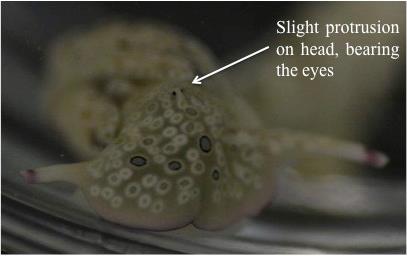External Morphology
Adult P. ocellatus body length extents in a range of 2.5cm to 6.4cm (Marshall, 1999; Pittman and Fiene, 2011).

They can be easily identified with their lateral rhinophores and dorsal-ventral flattened body that is covered by 2 flaps of parapodia. Their grayish cream coloured bodies are coated with their characteristic blue and yellow ocelli with alternating dark and lighter shades of rings. Most individuals have distinctive mauve coloured rhinophore tips and posterior ends.

|
|
|
|
|
|
|
The sea slug’s eyes can be seen on a slight protrusion on the dorsal region of the head (Marshall, 1999; Pittman and Fiene, 2011).
|
P. ocellatus originating form different regions of the Indo-Pacific have slightly varying spots patterns and body colour. This difference in body colouration and pattern variation could likely be correlated with the habitat where they occur at the different regions (Rudman, 2011). More information of the other variations can be seen at variations.

Upon closer observation, bright green ridges can be seen under their slightly translucent parapodia and head. These emerald ridges (lamellae) carries cells with photosynthetic abilities, that contributes to providing for the invertebrate when required (Marshall, 1999; Pittman and Fiene, 2011). |